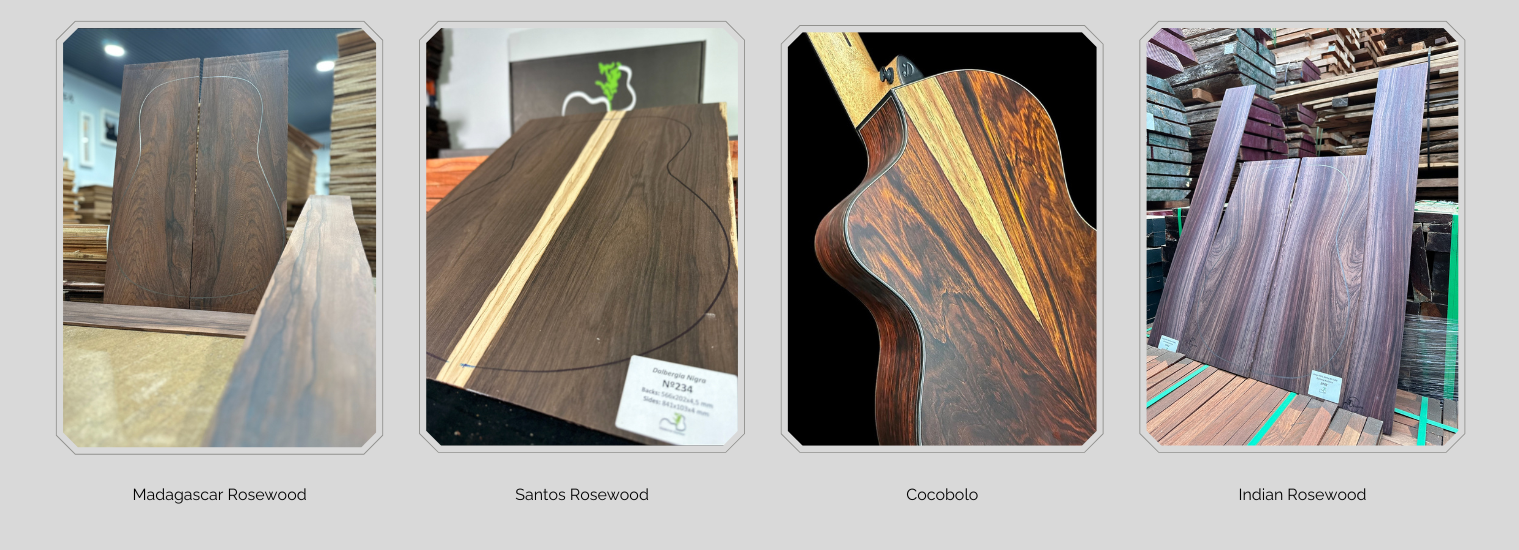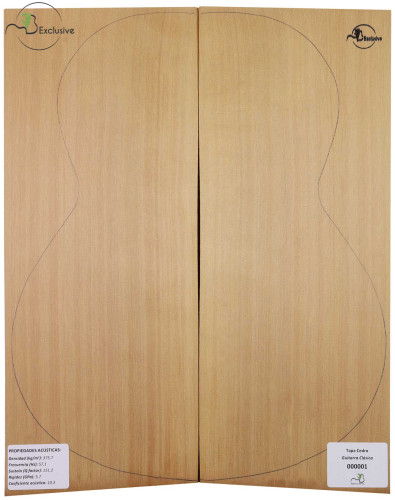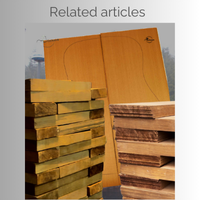- News
- 19 likes
- 1308 views
- 0 comments

Woods and luthiers that changed the spanish guitar
The Spanish guitar is one of the most iconic instruments in the world. Its characteristic sound is not only the product of the luthier’s skill but also of the choice and combination of the woods used in its construction. During the 20th century, Spain experienced a golden age of guitar making, with master luthiers perfecting their techniques and developing a unique relationship with the woods to create true masterpieces of sound.
Discover the relationship between the most influential Spanish guitar luthiers and the woods they chose to craft their works, and how these materials became fundamental protagonists in guitar construction.
1. The science behind woods as the key to a unique sound
Each type of wood brings unique acoustic and aesthetic characteristics to the guitar. Luthiers such as Antonio de Torres and José Ramírez III, leaders in classical guitar making, meticulously selected woods based on their physical properties like density, elasticity, and vibration capacity, factors that determine the instrument's timbre and sound projection.
The most commonly used woods for guitars
- Spruce (Picea abies) for the soundboard: German spruce is a classic choice for its rigidity and lightness, which provide a quick response and a powerful sound. Luthiers like Antonio de Torres set it as the standard in guitar construction.
- Cedar (Thuja plicata) for the soundboard: Cedar offers a warmer, deeper sound. Popularized by José Ramírez III, it is ideal for those seeking rich resonance in the mid and low tones.
- Rosewood (Dalbergia spp.) for sides and back: Rosewood adds harmonic complexity and depth to the sound due to its superior density. José Ramírez used it in combination with cedar to create guitars with great resonance.
- Cypress (Cupressus sempervirens) for sides and back: Cypress is appreciated for its lightness and its ability to produce a bright, percussive sound, essential for the flamenco style. It was the material chosen by Santos Hernández and Marcelo Barbero in guitars with the essential characteristics of the flamenco style.
- Ebony (Diospyros spp.) for the fingerboard: Ebony is the preferred wood for high-end guitar fingerboards due to its hardness and resistance to wear. It also has a smooth texture and deep black aesthetic, providing precision in the musician's touch.

2. 20th century luthiers, masters of woodworking
The 20th century was a time of innovation and refinement in Spanish lutherie. The guitar builders of this era developed a close bond with the woods they chose, creating instruments renowned both for their sound quality and for their meticulous aesthetics.
Meet some of the most renowned luthiers
- Santos Hernández (1873-1943): Remembered for his perfectionism in using spruce for soundboards and rosewood for the sides and back of his guitars, Hernández understood how the acoustic properties of these woods influenced the final sound. His instruments feature an internal design carefully calculated to maximize sound projection and clarity, with a special focus on stability and resonance.
- Domingo Esteso (1882-1937): Primarily used Spanish cypress for the sides and backs, giving his guitars a bright, percussive sound. A disciple of Manuel Ramírez, he specialized in flamenco guitars. His legacy was continued by his nephews, Mariano and Faustino Conde, who took his construction style to the pinnacle of the flamenco world.
- Marcelo Barbero (1904-1956): Masterfully used cypress and rosewood, achieving light guitars with great projection. He learned from Santos Hernández and, after his death, completed guitars in his master's workshop, gaining recognition in the lutherie world.
- Hermanos Conde (Mariano and Faustino Conde, born in 1916 and 1926, respectively): Their instruments, built with cypress and spruce, have been chosen by flamenco legends like Paco de Lucía. Heirs to the workshop of their uncle Domingo Esteso, they continued his legacy and became one of the most important houses of flamenco guitars.
- José Ramírez III (1922-1995): Introduced cedar for classical guitar soundboards in the 1960s, revolutionizing the sound of the modern classical guitar. His guitars combined Indian rosewood for the sides and back, achieving a rich, complex resonance. Ramírez was a pioneer in experimenting with different soundboard thicknesses and bracing patterns, seeking the maximum tonal expression.
- Francisco Barba (1939-present): Known for his flamenco guitars, which use Spanish cypress for the sides and back, with impeccable French polish finishes. A prominent Sevillian luthier, his craftsmanship enhances the natural beauty of the wood and improves the instrument's resonance. With special attention to the thickness of spruce tops and bracing, Barba achieves a perfect balance between projection and warmth in his flamenco guitars.
3. The most noteworthy wood species
One of the most significant changes in 20th-century lutherie was the use of Dalbergias, a family of woods that includes over 100 species, such as Indian rosewood (Dalbergia latifolia) and Brazilian rosewood (Dalbergia nigra), found in tropical and subtropical regions.
These woods, with their exceptional density and tonal quality, became favorites for the sides and backs of classical and flamenco guitars. Their incorporation transformed both the timbre and aesthetics, offering a deeper sound rich in harmonics.
The most noteworthy species
- Dalbergia latifolia (Indian rosewood): Appreciated for its warm, rich tone.
- Dalbergia nigra (Rio or Brazilian rosewood): Known for its aesthetic beauty and its ability to generate complex, bright tones.
- Dalbergia melanoxylon (Blackwood): Used for fingerboards due to its durability and resistance.
- Dalbergia retusa (Cocobolo): A vibrant, colorful wood perfect for sides and backs due to its resonance.

Sustainability and commitment to the future of woods in lutherie
Today, sustainability is key in the wood trade. Many Dalbergia species are protected by the Convention on International Trade in Endangered Species (CITES), and at Maderas Barber, we ensure that our woods comply with all regulations to guarantee their legality and sustainability. This allows luthiers to continue crafting high-quality instruments without compromising the environment.
Maderas Barber selects the best woods in the world
The Spanish guitar of the 20th century would not have achieved its iconic status without the perfect combination of woods chosen by luthiers. Each of these woods contributes a unique essence to the sound and aesthetics of the instrument.
At Maderas Barber, we select the best woods from around the world, ensuring that each piece meets the highest standards, so that the traditions of Spanish lutherie remain alive in the 21st century.
Discover the best woods for your guitar at Maderas Barber
In our online store, you'll find the best woods for classical guitar
Discover the best woods for your guitar at Maderas Barber
In our online store, you'll find the best woods for classical guitar
Receive the latest industry news, as well as offers and discounts to use on your next purchase.
Receive the latest industry news, as well as offers and discounts to use on your next purchase.






